
The Chief Statistician at the Scottish government today released a range of figures for Scotland from the EU’s Farm Structure Survey, including information on soil conservation, livestock breeding practice and use of manure.
The data are used to help monitor greenhouse gas emissions.
The results show that in Scotland about ten per cent of tillage used conservation methods, and about 13 per cent of land was left bare during the winter.
About three per cent of broadcast manure was ploughed in straight away (which would be beneficial for the environment and crop-growth), though much of the manure was spread on grassland.
Over a quarter of farms reported diversification, the most common form being tourism. Four per cent reported generating renewable energy for the market. One in six holdings reported that more than ten per cent of their turnover came from ‘other gainful activities’ at the location.
Of holdings that bred dairy cattle, two thirds used the best available genetic information, such as Estimated Breeding Values (EBVs). However on beef farms this was only 23 per cent, and on sheep farms eight per cent.
Fifty per cent of ewes were mated using a home-bred ram, with less than one per cent artificially inseminated. Just under half of the cows were mated using a brought-in bull, but with 23 per cent mated using artificial insemination.
In other data on the structure of farm ownership, about ninety per cent of farms were run on a day-to-day basis by the occupier or a member of their family. Five per cent of farms were owned by companies or institutions.
Twenty-nine per cent of those managing farms (occupiers or managers) were aged over 65, with a further 28 per cent aged 55 to 65. Four per cent were aged under 35. Thirty per cent were female, and just under one in five had completed at least two years of agricultural training.
